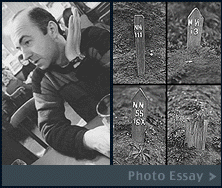|
|
|
It
wasn’t for three or four years after my exhibition of the unidentified
grave series that the truth about those events started being examined
and published. I photographed instinctively, even against my better
judgement. For that series, I had to go under cover of fog, before
the raids and everything, so that no one would see me. It was a
big challenge and I’m very fond of that series.
Many of the photos in that series are of grave sites of babies that
died during birth or a few days later. They mostly died because
they didn’t have a chance, a consequence of lousy hygiene or
a lack of water, or electricity, or whatever.
|
 |
In some cases, the parents didn’t have time to give them a name
or report their birth to the authorities. There were different ways
that deaths were registered and labeled during the war. The number
is the number under which the victim was filed in the books. Sometimes
there is a number for the location as well so they know where and
when the person died. But again this is the story of the war. In this
war, a transformation of victims occurred. In the end, it doesn’t
matter if they were Serbs or Muslims. People died all the time in
World War I and II, but they still got headstones with names and even
photos on them. Now it’s just a mass of human beings with just
numbers or a piece of wood marking that they never had a chance. I
could easily have
ended up in that cemetery. I know that somewhere in there is Zoran,
the man from the photo club who taught me photography.
When
I exhibited those photos of unidentified graves in Sarajevo during
the war, each photo had a candle in front of it. There was no electricity,
but at least we had candles. I thought we owed them that much –
a requiem of sorts. The exhibition of each photograph lasted only
as long as the candle in front of it burned. A lot of people came
to see it, even though we couldn’t put up posters with the date
and time printed on it for fear of the exhibition being shelled. But
I think it meant a lot to those who came. At one of my exhibitions,
you literally had to risk your life to get there. People had to cross
a bridge where snipers were shooting and where there were regular
raids. Nevertheless the place was packed, with perhaps about five
hundred people. It was very encouraging – I mean it’s nice
when you have an exhibition like
they do in the West, and people show up, have a drink and chat; but
when they risk their lives to get to the exhibition, it means much,
much more. That really gives you a will to continue because that proves
that it means something to other people.
Paris,
France
May
21, 2000 |
 |
|
